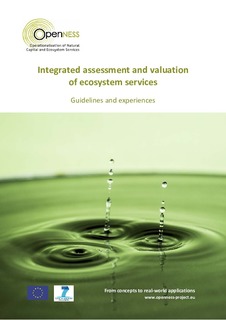| dc.description.abstract | As the ecosystemservice concept has become more widely recognised, so the number of biophysical, socio-cultural and monetary methods available to assess ecosystem services has increased. There is relatively little guidance on how to select and combine these methods into hybrid approaches that address policy purposes. Based on experiences from 27 case studies with 33 different assessment and valuation methods in the OpenNESS project, this report aims to fill some of that gap in science and practice. This report provides a number of tools that practitioners can use to plan, commission and evaluate integrated assessment and valuation studies of ecosystem services. The report starts by providing a rapid guide to commonly used biophysical, socio-cultural and monetary methods. A number of different ‘bottom-up’ and ‘top-down’ approaches to selecting methods fit-for-purpose are provided. OpenNESS method experts have developed detailed fact sheets on each method in the report appendix and available online at http://www.oppla.eu/. Network diagrams show the reader which assessment and valuation methods are most related and complementary. Decision trees provide a stepwise framework for scoping and integrating assessment and valuation studies which identifies the best method that is suitable to a specific purpose. Method consideration matrices provide a detailed list of several dozen method selection criteria, derived from case study experiences. Selection criteria tables are further specified for each suite of biophysical, socio-cultural and monetary valuation methods. An online method selection tool, develped in collaboration with the Opera’s project, demonstrates how combinations of study purposes, considerations and constraints can be used to identify portfolios of methods. Managers can use these method selection tables, matrices decision-trees and online tools to scope what is possible in their particular decision context. The material is also useful for specifying the terms of reference for ecosystem assessments. The report then shows how real world experiences in the OpenNESS case studies lead to the innovation and development of hybrid assessment methods that better addressed the particular needs of local decision-makers. The report summarises which combinations of biophysical modelling, mapping-modelling, expert-based, participatory, socio-cultural, monetary and integrative approaches were more likely to be combined in the case studies. We provide detailed examples using process diagrams to show how case studies scoped the study purpose, adapted and combined different method types. The real world process of applied research was non-linear and iterative, time consuming, but also creative. These examples can provide funders of applied research at EU and national level with a wider perspective on how to support innovative development of ecosystem service assessment methods. Real-life examples of method application and hybridisation show managers and researchers | |
